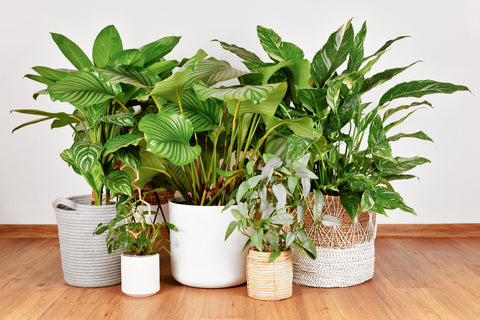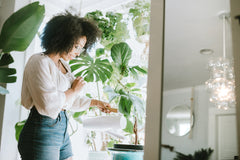House plants are our favorite way to elevate an indoor space. With so many shapes, sizes, colors and varieties to choose from, growing your collection is fun and rewarding. And many house plants are easy to care for, too!
While different kinds of house plants do require different care, there are some general care tips that apply to all house plants. In this guide, we’ll cover the basics to get you started. So, whether you’re a beginner or simply need a quick refresh, keep on reading!
Benefits of Plants
Having plants in your home is a smart idea. Spending time with plants does more than improve air quality—it reduces anxiety and promotes focus. We know it’s easy to become frustrated when a plant fails, but don’t give up! Take what you’ve learned and move forward, bringing that knowledge with you. Expand your plant knowledge by trying new plants and techniques until you find what works.
Location
Beyond the amount of light your plant receives in a specific location, you have to consider the overall environment. Use the list below to look at the area from a plant’s point of view. Consider the list below before placing your plant.
- Locate any vents nearby and see where the air flows and if it will hit your plant.
- Are there any hot or cool drafts? Ex. near an outside door or near a fridge or oven.
- What is the humidity like in the area?
- Is it in reach of curious kids and pets?
- Have other plants done well in this location? If so, what kind of plants were/are they?
Planting and Containers
Upon receiving your plant, it's best to keep it in its original container for at least a week to help it acclimate to your home. When ready to re-plant, choose quality potting soil and a container that has drainage holes. Avoid using any rocks or drainage aids in the bottom of your pot, as they do more harm than good and can lead to issues with your roots. If you need more drainage, then drill extra holes in the bottom.
The next container should be around 2 inches larger than the current container it’s in. Avoid the temptation to jump into a large pot. While your plant may eventually grow into that container, it will harm your plant to skip the in-between steps. Think of it like buying a child some shoes. Adult shoes, while they may eventually fit the child, serve no purpose at the moment since they aren’t the proper size.
If you’re absolutely in love with a container, but it's not the correct fit for your plant, we suggest hiding the smaller container in the larger one to get the look you’re going for. Remember to wash and reuse pots as your plants grow!

Soil
The most common struggle with house plants is getting the watering process nailed down. Over or underwatering your house plants happens to the best of us. The best thing you can do to fix any issues with over or underwatering before they happen is to choose the correct soil mix. The right soil mix prioritizes root health, creating a more resilient plant in times when too much or too little water is present.
The ideal house plant soil will have the following characteristics:
- Even texture throughout
- Light and fluffy while dry
- When squeezed together in your fist and released, it will hold its shape and then crumble when wet.
- Slightly acidic
Watering
Don’t be intimidated by watering your plants! If you have the correct container and a proper soil mix, you’ve already won half of the battle. You’ve got this!
When it comes time to water your house plant(s), the first step is ensuring your plant needs water. Do this by feeling the soil with your finger a few inches down in the pot. If the soil feels 75% dry, it’s time to water.
Never judge if a plant needs water just by looking at it, as the soil on top dries first while underneath may still be wet enough. If you’re not a fan of getting your fingers dirty, then invest in a water meter that tells you what the water level is with a glance and no soil on your fingers.
When watering your plants, do so at the base of the plant. The soil and roots need the water, not the leaves or stems—water slowly with room temperature water so as to not displace the soil. Tap water is just fine; just avoid using overly hot or cold water. Water until it runs out of the base freely.
Here are our tips for watering your house plants confidently:
- Avoid self-watering containers, watering bulbs, or other gadgets when starting out. These are helpful but not necessary and will not suit all plants. By all means, experiment with these features after your plant has been established for a while and you have a watering schedule down.
- Keep a log or set a reminder. We know you have a busy schedule, so take the pressure off and set a reminder to water your plants.
- Remember to always check your plants before you water. The amount of water a plant needs changes over time and is based on the season and whether it's growing or not.
Light
Plants see light in two ways: the intensity of the light and the duration of it. They don’t care if the light is natural or artificial; it’s all the same to a plant at the end of the day and is used in the same way to make energy to grow new leaves, stems, and roots.
Light Intensity
Here are different amounts of light that a plant could get at any point in time:
- Direct: There is no filter between the source of the light and the plant.
- Indirect: There is some filter, like a curtain or object, to diffuse the light that’s reaching the plant.
- Low: No direct light will reach the plant, but there’s enough ambient light that you could easily read a book in the area without the use of a lamp in the day.
This is how the different intensities of light might look in a room:

Light Duration
Here are the different classifications of light exposure for plants:
- Full Sun: 6- 8 hours of light per day
- Partial: 4-6 hours of light per day
- Shade: 4 or less hours of light per day
For example, a Fiddle Leaf Fig needs bright, indirect light all day. The best place for this plant would be a window, perhaps on the Southern or Eastern side of the house, where the light is bright.
The south side of your house receives the most light, while the northern side receives the least. If you’re not sure which direction that is, you can use your phone to figure out the direction!
If you can’t find the perfect spot for your house plants and feel they plants would do best with supplemental grow lights, we recommend you head over to our grow light guide to help find what is best for your plants.
Fertilizer
Your plants are indoors and in containers, which means they will rely on you for nutrients since, unlike outdoor plants, they cannot source them for themselves.
Most indoor plants will benefit from yearly fertilizer applications. We suggest an all-purpose house plant fertilizer. Every fertilizer is different, so please read the label for proper application and timing.
If you ever suspect you have over-fertilized your plant, you can remedy the imbalance with water. Fertilizer comes in the form of salts, so to remove the excess in the soil, the best method to help dissolve the salts is water. Water your plant deeply to flush out the extra fertilizer in the soil and you should be good to go.
Pruning
Minimal pruning is required for house plants. Most of the pruning required is to remove older or damaged leaves that no longer serve their function. To do this, take a sharp pair of pruners or scissors and remove the leaf at the base of where it attaches to the plant.
Troubleshooting
Even the most experienced plant parents will face issues here and there. Don’t get down on yourself and know that a sick plant is also one that can make a recovery with the right actions. The first sign that something might be wrong is often the leaves. It’s important to know what is typical and expected of your plant so that you can spot an issue early on.
The best way to stay on top of plant health is to look at your plant; under the leaves, the stems, and by checking the roots with your finger.
If you do face issues with your house plants, it's a good idea to separate it from the other plants until you know the cause of the issues. Next, determine what is going on by using a diagnosing guide with photos. Not seeing your issue here? Schedule a virtual plant house call with one of our Plant Experts.
Don’t get caught up in the comparison game. We love communities of house plant enthusiasts who share endless amounts of tips, tricks, and hacks, but remember, what works for others might not work for you. Each house has its own climate, and each plant is different. Experiment and try new things, but don’t get discouraged if you need to take a different approach. Take notes, learn, and create your own plant parenting style.
And if you're wanting a more in-depth look at house plant care, check out our expert-led House Plants 101 Course. This free, 6-part series covers everything you need to know about growing house plants like a pro. Check it out!


